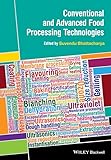Conventional and advanced food processing technologies / edited by Suvendu Bhattacharya.
Contributor(s): Bhattacharya, Suvendu [editor.]
Publisher: Chichester, West Sussex, UK ; Hoboken, NJ, USA : John Wiley & Sons, Ltd, Copyright date: c2015Description: xxvii, 712 pages : ill. (some col.) ; 25 cmContent type: text Media type: unmediated Carrier type: volumeISBN: 9781118406328 (hardback)Subject(s): Food industry and trade | TECHNOLOGY & ENGINEERING / Food ScienceAdditional physical formats: Online version:: Conventional and advanced food processing technologiesDDC classification: 664/.02 LOC classification: TP370 | .C67 2015Other classification: TEC012000 Online resources: Cover image Summary: "This book will discuss conventional and advanced food processing techniques in detail, outlining their specific applications along with examples, models, and suggestions for further reading for students and professionals, including those without an advanced background knowledge of food processing. Section1 will be dedicated to the conventional food processing techniques which are presently the most widely used globally, while Section 2 will look at the more advanced techniques which may indicate the future direction of food processing. Each chapter will have the following structure: Practical applications Machinery employed Models available Case study Recent trends References By following this structure, an dedicating each chapter to a different technology, the book will be a useful practical and academic reference, taking account of the practical questions which are of prime importance to the industry (such as the machinery required and costs involved), as well as the theoretical background and cutting edge research which academics will value. The inclusion of a detailed case study in each chapter is a major strength and will be a key point of interest for both practitioners and academics. The book will cover all the major processing technologies currently in use, and the advanced technologies that may be expected to be increasingly employed in the future. It will show that, in reality, conventional and advanced technologies are often operated together, and are not mutually exclusive. This book will be appropriate for professionals in the food processing industry, and also for postgraduate students seeking an insight into food processing technologies. The book brings together the practical applications and implications of different food processing operations into a single volume, ideal for reference and practical purposes alike. The fusion of the practical (case studies, machinery) and the theoretical (models and research) with an up-to-date sensibility (each chapter contains a section which focuses explicitly on recent trends), makes this book ideal for industry, academia and reference use"-- Provided by publisher.Summary: "This book will discuss conventional and advanced food processing techniques in detail, outlining their specific applications along with examples, models, and suggestions for further reading for students and professionals, including those without an advanced background knowledge of food processing"-- Provided by publisher.| Item type | Current location | Home library | Call number | Copy number | Status | Date due | Barcode | Item holds |
|---|---|---|---|---|---|---|---|---|
| Circulation | Sibalom | Sibalom Circulation | 664.02 C7667 2015 (Browse shelf) | 1 | Available | UAMAIN 11285 |
Includes bibliographical references and index.
"This book will discuss conventional and advanced food processing techniques in detail, outlining their specific applications along with examples, models, and suggestions for further reading for students and professionals, including those without an advanced background knowledge of food processing. Section1 will be dedicated to the conventional food processing techniques which are presently the most widely used globally, while Section 2 will look at the more advanced techniques which may indicate the future direction of food processing. Each chapter will have the following structure: Practical applications Machinery employed Models available Case study Recent trends References By following this structure, an dedicating each chapter to a different technology, the book will be a useful practical and academic reference, taking account of the practical questions which are of prime importance to the industry (such as the machinery required and costs involved), as well as the theoretical background and cutting edge research which academics will value. The inclusion of a detailed case study in each chapter is a major strength and will be a key point of interest for both practitioners and academics. The book will cover all the major processing technologies currently in use, and the advanced technologies that may be expected to be increasingly employed in the future. It will show that, in reality, conventional and advanced technologies are often operated together, and are not mutually exclusive. This book will be appropriate for professionals in the food processing industry, and also for postgraduate students seeking an insight into food processing technologies. The book brings together the practical applications and implications of different food processing operations into a single volume, ideal for reference and practical purposes alike. The fusion of the practical (case studies, machinery) and the theoretical (models and research) with an up-to-date sensibility (each chapter contains a section which focuses explicitly on recent trends), makes this book ideal for industry, academia and reference use"-- Provided by publisher.
"This book will discuss conventional and advanced food processing techniques in detail, outlining their specific applications along with examples, models, and suggestions for further reading for students and professionals, including those without an advanced background knowledge of food processing"-- Provided by publisher.

There are no comments for this item.